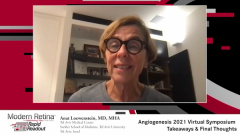
Angiogenesis 2021 Virtual Symposium Takeaways & Final Thoughts
Angiogenesis, Exudation, and Degeneration 2021 Virtual Symposium highlights and thoughts on current treatments options for DME and exudative AMD are discussed.
Episodes in this series
Anat Loewenstein, MD, MHA: In the Angiogenesis, Exudation, and Degeneration 2021 virtual symposium, the role of Home OCT was presented in the treatment of patients with neovascular macular degeneration. It has been shown that elderly patients with neovascular macular degeneration are able to self-image on the Home OCT device and produce high grade images that are mounted to a cloud and interpreted by artificial intelligence, with alerts sent to the patient and the physician if re-treatment is needed. This technology allows for the patient to be treated in a timely manner when fluid accumulates, avoid noninjection visits, quantify the volume of fluid at all times, and see individualized treatment responses to various drug therapies.
The Angiogenesis, Exudation, and Degeneration 2021 virtual symposium showed very exciting data about new treatments for non-neovascular macular degeneration; for example, geographic atrophy. The meeting emphasized all of the new treatments combating complement dysfunction in these patients. Viral-mounted therapies that are given subretinally, intravitreally, or suprachoroidally provide us with the potential to treat this unmet need of management of geographic atrophy.
For the past decade, we have had excellent treatment options for our patients with neovascular macular degeneration and diabetic macular edema. Still, these treatments are not ideal. They do initially provide us with good visual acuity for our patients. However, to get to these good visual acuity results, patients need to be monitored in the clinic very frequently and get frequent injections. Since this is not feasible in the long term on a large scale, many patients are undertreated, not monitored enough, and therefore have poorer outcomes compared to the people in the trials. Nowadays, we’re starting to have the means for the patient to receive fewer injections by way of treatments that have a longer duration, dual function, and the ability to monitor the patients without them coming to the clinic for noninjection visits. This holds a lot of promise that we will soon be able to treat our patients in a more effective manner. We will be able to mostly have them only come in for injection visits, with longer intervals between injections than what we have nowadays. As a result, I expect that the compliance of the patient and the ability of the system to accommodate this huge number of patients will increase, and therefore the final visual acuity outcomes will be significantly better.
Transcript edited for clarity.
Newsletter
Get the essential updates shaping the future of pharma manufacturing and compliance—subscribe today to Pharmaceutical Technology and never miss a breakthrough.













































